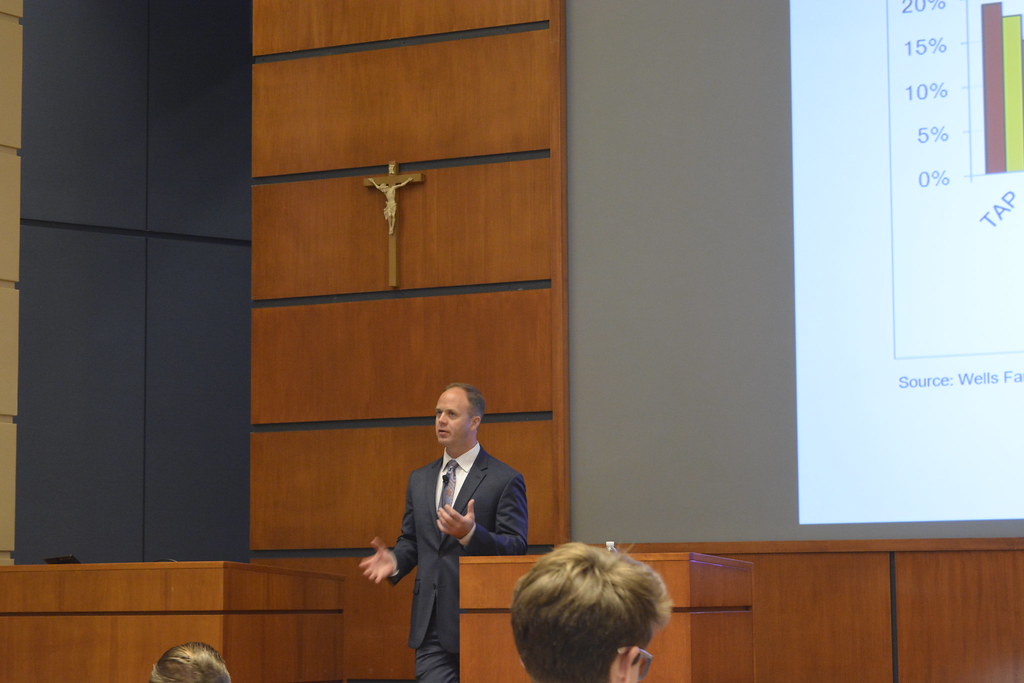On October 3, Mat Klody of MCN Capital Management hosted “The Art of Short Selling.” The event was the fourth in the Fall Semester’sRobert K. Wilmouth Speaker Series, a number of lectures hosted by NDIGI designed to further students’ knowledge of the science and art of investing. The event was designed to educate students on short selling and give accessible examples of the practice.
Klody is the founder and current portfolio manager at MCN Capital Management, LLC. Before founding MCN, Klody served as Senior Vice President and Senior Analyst at Sheffield Asset Management, a long/short equity hedge fund out of Chicago with $500MM in AUM. Prior to that, he was one of two analysts at Alleghany Corporation covering a $1BN long only equity portfolio. Klody graduated summa cum laude from the University of Notre Dame with a degree in finance and business economics. While at Notre Dame, he was an assistant PM for the Investment Club and a member of the AIM V class. He is a Chartered Financial Analyst.
Trends in the Market
Klody highlighted differences in the markets from the time when he was an undergraduate to now, emphasizing the series of bubbles, crashes and dramatic price fluctuations during that time. Moreover, Klody described the current trend toward passive investment management. When discussing inefficient markets, he explained that they create an opportunity for intrinsic value investors but noted that investors must be disciplined and patient in order to generate superior risk-adjusted returns over time. This market inefficiency is driven by short term behavior by market players who are looking to make a quick profit. Klody discussed an effective strategy to take advantage of inefficient markets: short selling.
What is Short Selling?
Short selling is the practice of selling securities not currently owned, with the hope of repurchasing those securities at a discounted price. It is motivated and driven in the belief that the security is overpriced. Klody pointed out that the intrinsic value of the security can greatly differ from the market price. By establishing the intrinsic value, investors can see if the market price reflects an accurate price point or determine whether the security is in fact overpriced or underpriced. If an investor believes a security’s intrinsic value is less than its current market price, they will sell the security prior to the price drop, thereby making a profit on the sale of the security.
Short selling can greatly enhance the risk-to-reward ratio in an overall portfolio. It can generate positive absolute returns as well as preserve capital during market dislocations by offsetting long book losses. By capitalizing on unsustainable market anomalies, it can provide a low cost source of capital that can strengthen an overall portfolio. However, while short selling can produce quality returns, Klody warned that there are risks to short selling including unlimited potential loss, inflation, the short squeeze phenomenon, and the fact that markets generally increase.
Example of Short Selling
Klody provided an example in order for the students to form a better understanding of the art of short selling. An investor wants to short 100 shares of Coca-Cola. Therefore, he borrows 100 shares from a broker and then sells those shares at the current market price - $46. He then collects $4,600 (46 x 100) and repurchases the shares in the future. If the market price of Coca-Cola is under $46 when the investor decides to repurchase, the trade is profitable. However, if the market price is above $46, the trade is not profitable.
Timing and Catalysts of Short Selling
Klody pointed out that the art of short selling takes patience and correct timing. Using data and examples from real-world companies, Klody showed how the optimal time to sell and buy is crucial to actually generate absolute returns from short selling. He provided some case studies of both historical and current positions. Good shorts materialize from a multitude of factors, including fads and fashions, industry and business cycles and secular changes. Most importantly, investors must truly believe a specific security is overvalued and hold that conviction until the inefficient market reflects their beliefs.
Klody concluded the evening by giving advice to students entering the investment management industry. Whether they hope to apply the art of short selling or enter another aspect of the industry, he gave students an overview of the investment process: sourcing, due diligence, investment, monitoring, and divestment. Klody pointed out that time management and discernment skills are crucial for success in today’s investment environment. He closed the evening by sharing the names of some of his favorite books and websites that have helped him as well as maxims that he has learned from his experience in the world of investing.
